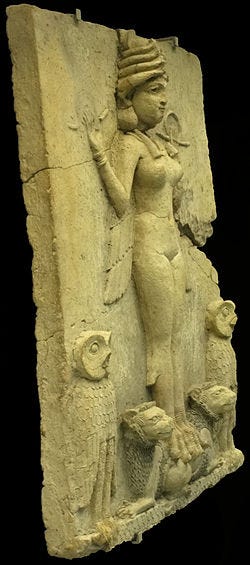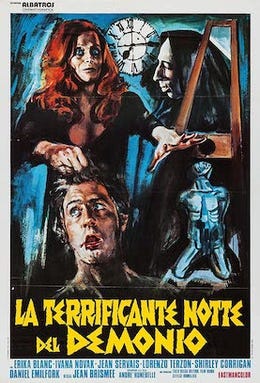Fondling Phantoms: Sex Fiends in Korean Hauntings
Korean ghostlore isn't rich with pervert spooks but some say they've encountered them.
In my upcoming book collecting a portion of my twenty-plus years of research into supposed supernatural encounters in Korea, the second chapter, called ‘The Dead Live Here’, focuses on the most classic setting for all ghost stories: haunted houses. The chapter kicks off with claimed encounters of spectral torment that disrupted sleep. I lead from there into the next section about the worst kind of spooks in folklore, the ones that molest the living. I’m sharing that bit today.
The main part of the section is below, where I highlight a few examples of these groping ghouls across folklore, art, and media. They’re rare in Korean lore but not absent. The section finishes with one of the weirdest, grossest, and most terrifying encounters I’ve recorded in Korea.
Remember, as with all of these sneak peeks, this section might change/be corrected through editing and be different when published.
Enjoy!
Related to ghosts who rob us of sleep, but more fiendish and deplorable, is an incubus. Folklore tells us that an incubus is a malevolent male spirit or demon who, like its female counterpart, succubus, molests sleeping victims. There is no worse disruption of privacy, no greater depravity within tales of the supernatural than these cacodemons. Mentions of such hypersexual spectres stretch way back into the cobwebbed corridors of folk belief. The Mesopotamian demon Ardat-lili is a sort of proto-succubus who focused her sexual appetites on young men. She was kin to a hoard of evil spirits called lili, who, over time and through various reinterpretations and cultural fusions, gave rise to Lilith. In folklore postdating the Torah, Lilith is said to have been Adam's first wife, and therefore the first woman. Her tale focuses on her agency and refusal to yield to Adam, culminating in her becoming a succubus. She is mentioned in the Talmud, which warns readers against sleeping alone in a house lest Lilith come and take them. Arguably, the roots of Lilith, and therefore succubi, are buried so deep in time, she may be the oldest extant figure in Abrahamic mythology, perhaps older than even Yahweh.
These deviant spirits are also found in Buddhism, namely in interpretations of dharani, incantations for creating merit and protecting against evil. One such dharani is Amoghapasha, which is associated with the divine being Avalokitesvara. Reciting the Amoghapasha is believed to guard against sinister ghosts who may drain you of energy and slip under your blankets with you while you sleep. Broadly, Avalokitesvara, called Gwan-eum in Korean, is associated with protection rites. It's said that lighting 108 incense sticks in front of Gwan-eum's image, and chanting a specific dharani, can dispel ghosts from your home.
These fondling phantoms appear in works of art, as well. Henry Fuseli's famed painting The Nightmare depicts an incubus tormenting a sleeping woman. A 2025 comic book series written and drawn by Corin Howell features a main character with succubus-like traits. To form, the character's name and the comic's title is Lilith. And they're found in film, somewhat notably in 1966's Incubus. In the 1971 Belgian-Italian movie The Devil's Nightmare, a contract with Satan stipulates a family to suffer a legacy of succubi. Perhaps the most famous movie succubus is played for laughs in the original Ghostbusters.
While these fiends torment cultures across time, popping up in religion, art, and media, they aren't very common in Korean tradition. A close analogue is the gumi-ho, or nine-tailed fox, a shapeshifter who morphs between the form of a fox and a woman. Variations on tales of gumi-ho hold that they appear to sleeping men or boys to devour their ki, or life energy. One story tells of a terrified student hiding in a dark corner, watching a gumi-ho slowly murder ninety-nine of his sleeping schoolmates. One-by-one, she straddles her victims, leans forward, wraps her lips over theirs, slips her tongue into their mouths, and sucks them clean of their ki. In more well known variations of gumi-ho tales, especially in modern retellings, the creature instead devours the innards of her victims. The relative popularity of these savage variations aside, the sensual, succubi-esque version of gumi-ho is creepier, moodier, and far more interesting.
Although Korean folklore is lacking in these ecto-deviants, it's important to note that alleged ghost encounters don't always line up with those from tradition. As such, there are contemporary claims in Korea of run-ins with entities that could be defined as incubi. One such claim comes from a pair of Seoulites, Han Ji-yeon and her boyfriend Lee Jeong-hu.
In early 2024, Ji-yeon began spending more time at Jeong-hu's apartment, sleeping there several nights a week. Jeong-hu would wake in the mornings and leave for work. Ji-yeon would do the same some time later. They'd come home, happily pass their evenings together, go to bed, then wake the next morning to start it all again. They enjoyed these nights together, the way young lovers do, and it was by all measures a normal life. It wasn't long, however, before the apartment became a place neither wished to return to at the end of the day.
Keep reading with a 7-day free trial
Subscribe to Shawn Morrissey to keep reading this post and get 7 days of free access to the full post archives.


